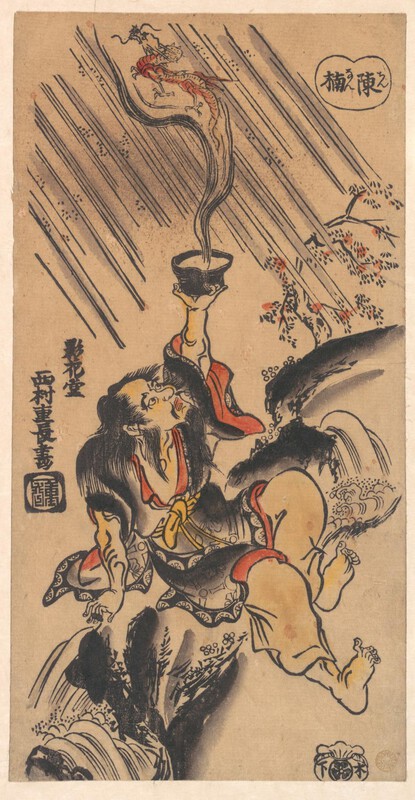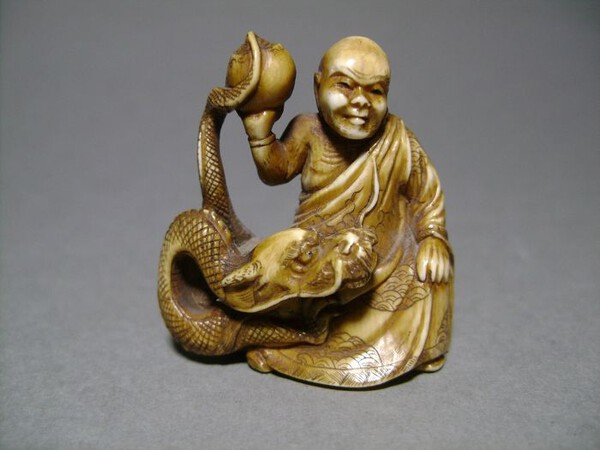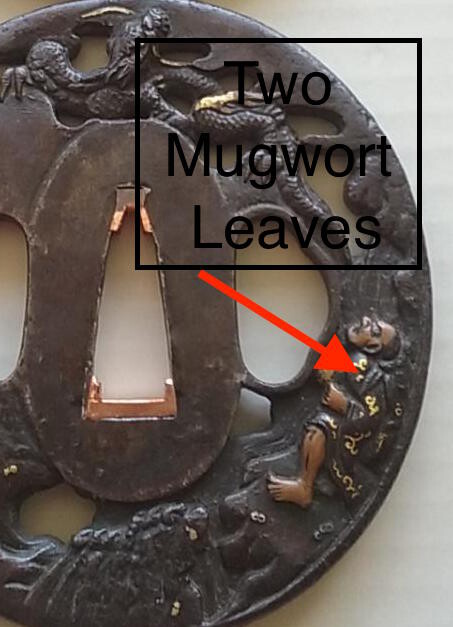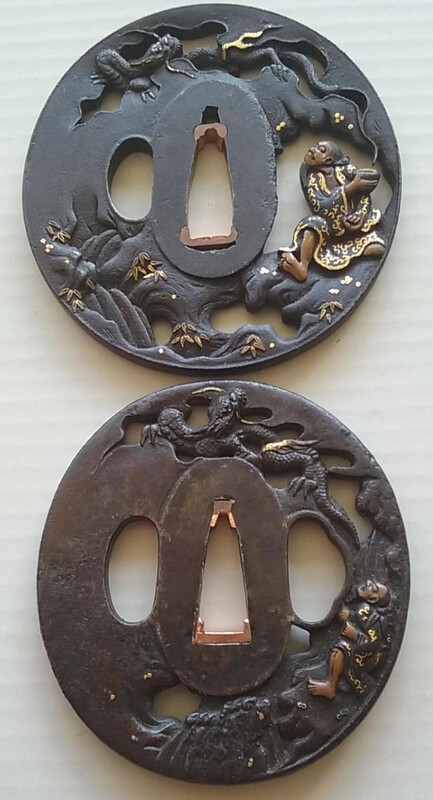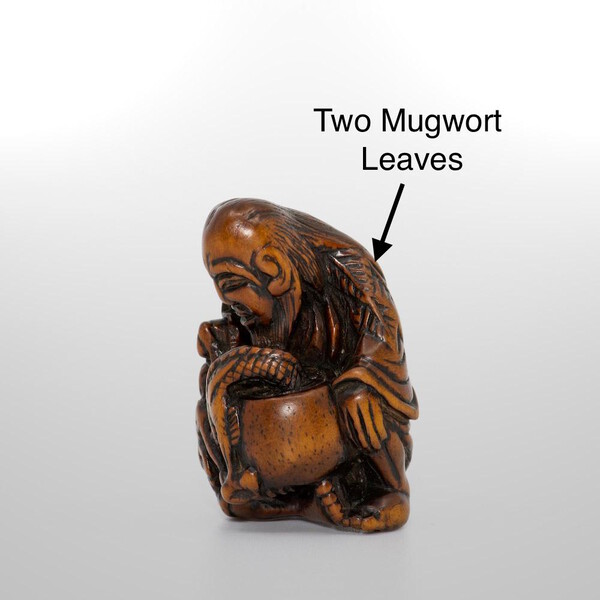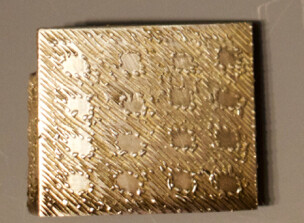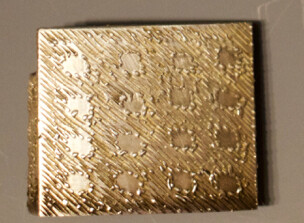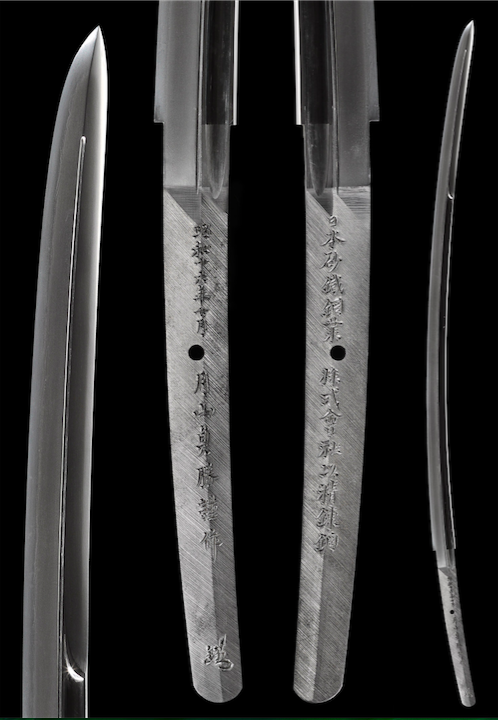-
Posts
858 -
Joined
-
Last visited
-
Days Won
7
Content Type
Profiles
Forums
Events
Store
Downloads
Gallery
Everything posted by Tanto54
-
Maruo is correct (and, well, StevenK is not...) This is definitely Chinnan Sennin. Here's why. First, Handaka Sonja is one of the sixteen rakan or arhats and they are almost alway depicted bald, and the person on both of your tsuba has a full head of hair. Second, the rakan (and Handaka Sonja) are almost always shown wearing Buddhist style clothing (i.e., one bare shoulder), and the person on your tsuba is not. Third, Pietro was correct about mugwort leaves often being a clue to the person being a Sennin (even though he apparently missed the mugwort leaves and therefore picked the wrong "camp"). If you look carefully on one of your tsuba, you can see that the person has a mugwort leaves collar. Therefore, these must be Chinnan Sennin and are similar because they were modeled on one of the paintings in one of the tosogu theme model books. Your Tsuba: Not Bald - not Buddhist dress Chinnan Sennin: Not Bald - Looks just like your tsuba Handaka Sonja: Bald - clothes off one shoulder Mugwort Leaves on Your Tsuba: You can see two of the Mugwort Leaves of his collar Sennin with Mugwort Leaves Collar:
-
Dear Brandon, Welcome to the NMB. While I've never been to the particular meetings that Barry described above, I can tell you that the best way to learn about swords is to join a group and go to meetings. Therefore, I'd highly recommend that you attend the meetings with Barry. I'll bet that if you get to know them, they will be happy to share some of their treasures and hard earned knowledge with you. There is no better way of learning than seeing swords in person. There are a few shows around the USA each year, and some of the members here are responsible for those shows and work very hard to make them a success. However, in all honesty, it does appear that the shows are starting to die away recently (in the "old days" that was one of the only ways to see a bunch of swords, but the availability of fairly high resolution pictures and the ability to purchase on the Internet seems to be killing/hurting the sword shows). The largest in the US is in San Francisco. The big annual show in Japan is called DTI and is in Tokyo. It is many times the size of the largest US show and the quality of items on the average is several times higher (but so are the average prices...) It is easy to go to Japan and visit the show, even if you don't speak any Japanese. Welcome again, and I hope that you'll love nihonto and tosogu as much as we do. P.S. I saw something on the Internet that said Japan was considering promoting the restart of its tourism by subsidizing vacations to Japan by as much as 50%. Might want to keep this in mind - DTI is in the beginning of November this year.
-
Dear Curtis, You've received some help on the sword, but you also asked about the fittings. The menuki (the two small metal ornaments under the wrapping on each side of the handle) are dragons - male (with sword at the end of his tail) and female. Your fuchigashira (collar and pommel parts of the handle) have nunome zogan rain dragons. Numome zogan is an "on-lay" technique of adding one metal over another metal, literally “cloth inlay,” where the artist engraves lines in the surface of one metal and then pushes the other metal into those engraved lines. In the case of your fuchigashira, the artist has onlayed thin gold wire in the shape of a special kind of dragon called a rain dragon. I've linked a Youtube video of Ford explaining this technique below. You appear to be missing several parts: a habaki (sword collar) and tsuba (bladeguard). I've included pictures of what they might look like below.
-
I hope my friend, Subaku Samurai, will stop in and post some of his Sadakatsu & Gassan swords. He has some great ones with very interesting background stories.
-
- 149 replies
-
- 14
-

-
Dear Mike, All of the characters are the same word - kotobuki (meaning longevity) - in different style kanji.
-
Robert, I think that you can have Buyee repackage your shipments (small additional cost). In my experience, the shipping within Japan (from the seller to Buyee) is very good (packages handled carefully and respectfully, so damage is much less likely). The problem is outside Japan and in our own country (I'm ashamed to say...)
-
Suggestion to All: When purchasing tosogu or nihonto via post or courier, send simple, clear instructions to the seller (respectfully asking them to pack the tsuba / sword separately) AND a simple note (Printed in large font) for them to include with the packed item warning the post office / customs not to touch the item with bare hands because the oil from their hands can ruin the blade/item (and other pertinent warnings). Keep it short and clear (because of language problems and most workers won't read more than 2 sentences....) For high priced items, ask the seller to include a pair of gloves in the package (for customs/any inspectors).
-
越翁誌 [Echizen/Echigo/Etcchu Old Man Wrote This][maybe...]
-
Dear Matt, What an awesome find! That is so cool and perfect sized for a tosogu collector. Your collection and especially your Natsuo collection is really looking great - congratulations!
-
Sorry Curran, bad joke...
-
Dear Curran, When you say that Robert (Surfson) has "a nice set", which topic were you referring to - the Tanuki or the guribori???
-
Gassan Sadakatsu - true Master!
-
Regardless of which school made it, the shippo (cloisonné) is well done.... The tsuba needs some TLC, but I think that it would be very nice if it were cleaned up.
-
Just a fun fact about the tsuba that Luis posted (the high priced one - reposted below). Did you see that the Tanuki is resting the hot tea kettle, plate and leg on his nut sack? Tanuki have various powers in Japanese myth including the ability to take human (or other) form, drum on their bellies to attract humans, and grow their nut sacks to enormous sizes and use them (their nut sacks) to kill humans by crushing them. On tosogu, you will often see tanuki drumming on their bellies, in the process of changing back from a tea kettle form, or rarely with a huge nut sack like this tsuba.
-
Dear Dale, Thanks for the heads up! How do you think it was made? Mass production by drop forging or casting? Looks like the gold was painted on and the monkey soldered on afterwards. What about the sekigane? Did they really go to the effort of adding those or are they just painted on? (can't tell from the picture)
-
Dear David, I know it is sacrilege, but personally I'm not a fan of most "authentic" Nobuie tsuba either. Strangely, I do like your tsuba - perhaps it's your excellent photos. There are some things that I'm wondering about though. Regardless of the fat/thin Nobuie mei issues, the lines of the mei on your tsuba seem far more corroded than the rest of incised lines on the tsuba like some of the turtleshell carving (perhaps trying to make the mei more difficult to evaluate?). Similarly, despite the [artificial?] look of significant age and corrosion elsewhere, the anna and mimi seem relatively fresh and crisp.
-
Dear Tom, Welcome to the addicting World of Tosogu! This looks like a much better acquisition than many of us started with. With some careful cleanup and attention to the active rust, this could look great. Just search for care and cleaning tips on this site and you will find lots of posts (get an antler or old peice of ivory and get to work - slow and careful - avoid the gold and other inlay areas). I can't be sure from the pictures, but I think that this depicts Yoshitsune and Benkei fighting down the cliffs in the famous battle of Ichi-No-Tani in the Gempei Wars.
-
Dear Jean, Brian reposts the picture later in the first page of the original thread. But for your convenience, here is Grev's 1st Tsuba:
-
Enjoyable read - thanks Grev. Can I ask, do you still have it and what do you think of it today?
-

Information / Pricing on Lacquer Box
Tanto54 replied to TheGermanBastard's topic in Other Japanese Arts
Hi Luis, Because of the hinges and lock, I think this is Taisho or later and made for export (more collectible, antique, Japanese lacquer boxes don't have hinges or locks...) Sorry to bring bad news, but I've seen things like this go for $5 - $50 over the years on ebay. A secondhand store would probably list it around $30 - $50. I think that you would be very fortunate to get $50 for it... -
-
Dear Piers, I'm pretty sure that I've figured it out. The standard set of three things for a Zen Temple's Tokonoma (entrance or alcove display) is: 1. incense, 2. nyoi-bo [shippei or priest's scepter] and 3. kakejiku (scroll painting). Your tsuba has incense and nyoi on the back and a white plum tree (shiraume) on the front. The white plum tree is actually the third item - the kakejiku (scroll painting of a white plum tree). That's why it has a 金印銘 Kin-in Mei which are used to sign kakejiku (scroll paintings). Based on the placement of the signature, I think that it is probably the painter's signature (from the Kakejiku that was copied) instead of the tsubashi's. In this case, there are several famous kakejiku painters who were named Tani (like Tani Buncho) who painted shiraume (white plum trees) exactly like the one on your tsuba.
-

Help w/ papers - translation of signature on Yasuchika tsuba
Tanto54 replied to Curran's topic in Translation Assistance
Not respected, advanced or super, but.... Ansei Three [year] Hinoe Tatsu [#53 of zodiak] Winter Season Responding to Tamiya Norimatsu's [or Sokushu's] order Hogen Yasuchika kao Love this tsuba! Ampo says hi... -
+1 to Sebastien - looks like Brasso or a similar abrasive metal polish was used on it and left the light tan residue. Might have even had a dark patina before it was polished up.


